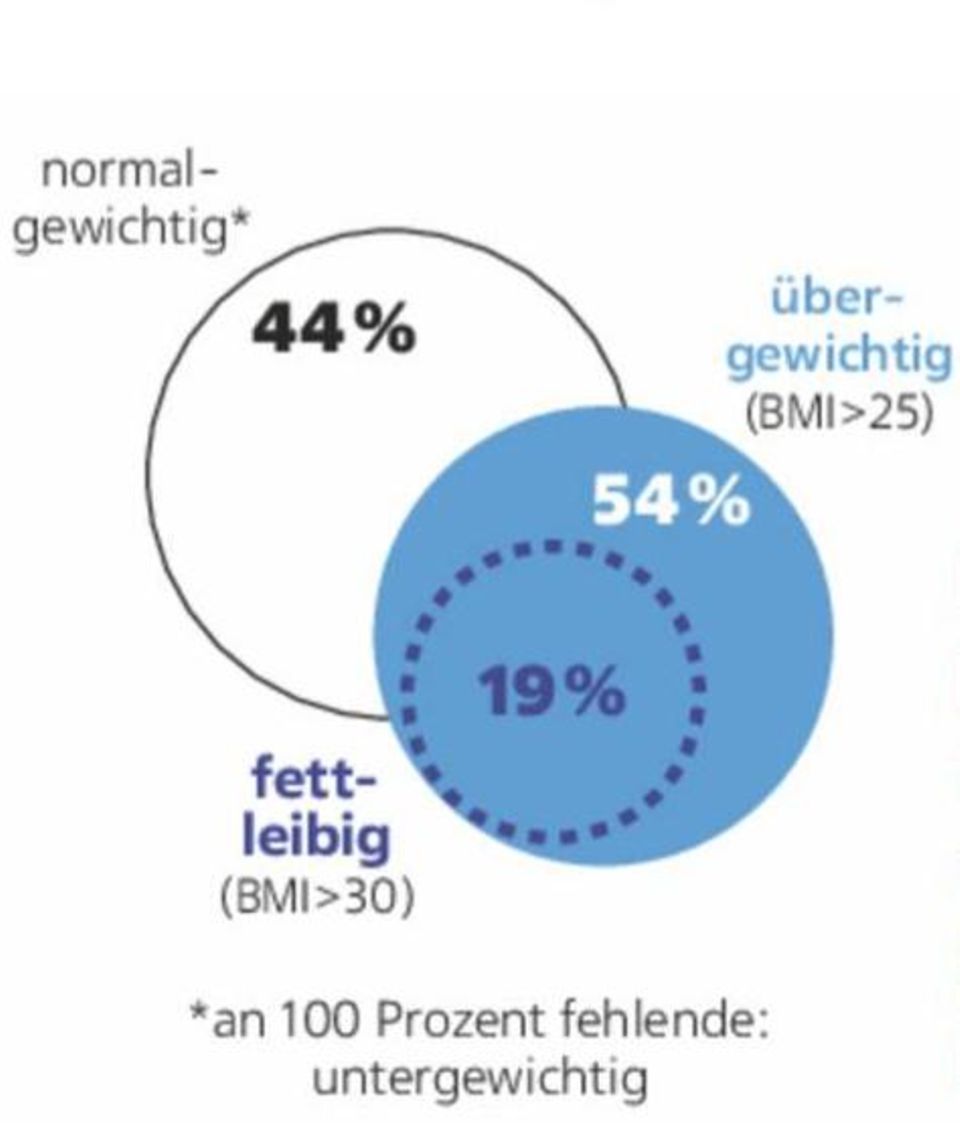One spade a week and the fat melts – can it work that easily? About the opportunities and risks of new weight loss methods.
How do the syringes work?
The weight loss drug Wegovy contains a higher dose of the active ingredient semaglutide than Ozempic, which is actually approved as a diabetes medication – even if it is repeatedly prescribed “off label” (outside of its intended purpose) for weight loss. To put it simply: Semaglutide tricks the body into thinking that it has just received food.
It is a replica of the natural hormone glucagon-like peptide-1 (GLP-1), which is released into the blood by intestinal cells after eating and then docks on special GLP-1 receptors that many of our body cells have. Like the natural hormone, semaglutide causes the brain to feel full (see graphic above). It also slows down gastric emptying and makes you feel full for longer. In studies with Wegovy, a large proportion of the test subjects managed to lose at least five percent of their body weight. In combination with a diet program, obese people with high doses of semaglutide achieved an average of 15 percent in around a year. This makes semaglutide significantly more effective than older active ingredients. But: You apparently reach a plateau after about a year and your weight stops falling.
Can you trust the many positive reports about Wegovy and Ozempic?
Today, the effect and side effects of every approved drug must be examined in clinical studies (tests on humans) before it is brought onto the market. These studies have high standards. For semaglutide, they found an unusually large weight loss effect, which (so far) does not appear to be offset by a high risk of serious side effects. But even sophisticated studies have blind spots: Even if they last several years, they do not allow any conclusions to be drawn about long-term consequences, which may only become apparent after ten or 20 years. And about side effects that are so rare that they only affect one in 100,000 people.
In addition, drug studies are usually supported by pharmaceutical companies. This can lead to a “publication bias”: people would rather publish success stories than negative results. And finally, in order to bring a new drug to market, the experts often receive a lot of advertising and financial support, especially for drugs with blockbuster potential. These marketing offensives are legal within certain limits. In principle, however, the following applies: What celebrities or influencers say about weight loss products should never be the basis for your own therapy decisions.
Who are the funds intended for?
Patients with type 2 diabetes should receive Ozempic. Wegovy targets people who are classified as obese, i.e. who have a body mass index (BMI) of more than 30. Overweight people with other health problems such as type 2 diabetes or high blood pressure can get Wegovy from a BMI of 27. A third target group is young people aged twelve and over who are obese. In all of these cases, the injection should never be used alone, but only in addition to a reduced-calorie diet and more exercise.
How do you get the injections – and for how long?
You inject semaglutide under the skin of your stomach, thigh or upper arm once a week. To do this, you press a pen-like injection pen against the skin. Treatment begins with a low dose and increases slowly over several months. The data currently suggests that you will gain significant weight again after stopping. This means that many obese people would have to take semaglutide permanently to maintain their weight.
Are the costs reimbursed by statutory health insurance?
No, so far the health insurance companies do not pay for weight loss medications. The basis is the “Lifestyle” paragraph 34 in the Social Security Code V: It excludes medications that primarily serve to improve the “quality of life”. This applies to potency, hair growth and weight loss products. Semaglutide is therefore prescribed on a private prescription. Depending on the dosage, the drugs cost different amounts: a syringe with the lowest dose costs around 43 euros, which is around 172 euros per month. A syringe with the highest dose costs around 75 euros, which works out to around 300 euros per month. While private health insurance companies will certainly reimburse Wegovy if prescribed as intended, health-relevant studies still need to be evaluated in order for the costs to be covered by statutory health insurance: for example, the data that has just been published, according to which people who use semaglutide not only lose weight, but also have fewer accompanying diseases such as heart attacks or develop strokes.
Why a “weight loss injection” at all? Can’t you just eat less and exercise more?
Many people actually manage to lose weight with a lot of discipline, a healthy diet and exercise. Behavioral therapy can also help because you learn to observe your eating habits and control yourself better. But even in well-structured weight loss programs under medical supervision, failures and terminations are common. And that especially applies to the time afterwards, when you are on your own again. Some people are unable to maintain their weight despite their best efforts. This also has to do with the fact that numerous control processes in our body are programmed for calorie intake: sweet things stimulate the reward center in the brain, fatty things feel pleasant on the tongue, and any excess energy is carefully “put aside” by the organism – as Fat deposits for bad times.

There are also people who are genetically more prone to gaining weight than others: More than 400 genes have been identified in connection with overweight and obesity. Some affect appetite or satiety, others affect metabolism, body fat distribution or the tendency to respond to stress by eating. This is one of the reasons why obesity was recognized as a disease by the World Health Organization (WHO) in 1997. And it seems to be a disease that can reinforce itself. The more kilos someone has piled on, the more their metabolism gets out of control. In animal studies, constant overfeeding leads to inflammation in the hypothalamus, the control center in the brain that regulates hunger and satiety. Obese people also have a noticeably enlarged hypothalamus, which in turn could affect their eating behavior. In addition, in a constantly full stomach, the stretch receptors no longer react as well – these are nerve cells that are supposed to tell the brain: Now it’s enough.
What risks and side effects are there?
The most common adverse effects include nausea and vomiting, diarrhea, constipation and headache. In the pivotal studies, around seven percent of participants discontinued semaglutide treatment before the end of a year. Some cases of acute pancreatitis appear to be related to the active ingredient, and possibly also intestinal obstructions. The European Medicines Agency (EMA) recently initiated a review of substances that bind to the GLP-1 receptors (such as semaglutide). The reason: The Icelandic Medicines Agency reported that some patients expressed thoughts of suicide or self-harm after taking the medication. Whether semaglutide increases the risk of thyroid cancer is also being examined.
And: The slowed gastric emptying can affect the effectiveness of other medications. Anyone who takes insulin at the same time has an increased risk of hypoglycemia because semaglutide also lowers blood sugar levels. Doctors also report a psychological side effect that causes patients to stop taking the drug: chronically bad mood.
Who should stay away from semaglutide?
People who are slightly overweight and want to lose a few pounds quickly are not part of the target group. Wegovy is intended for obese people and overweight people with medically diagnosed health problems, Ozempic for type 2 diabetics. Anyone who has the medication prescribed to just lose a few kilos has practically no health benefit and may take the injections away from sick people. There have already been supply bottlenecks in this country with the diabetes drug Ozempic – presumably because it is often prescribed “off label” for weight loss. This could increase if the injections are requested by people who are only slightly overweight. Pregnant or breastfeeding women and people with a family history of thyroid cancer should not take semaglutide.
For very obese people with a BMI of 40 or more (or BMI 35+ with other illnesses), weight-regulating surgery such as a stomach reduction is often the better solution because the effect of the injections is too small to significantly improve health.
More on the subject:
Source: Stern
I’m Caroline, a journalist and author for 24 Hours Worlds. I specialize in health-related news and stories, bringing real-world impact to readers across the globe. With my experience in journalism and writing in both print and online formats, I strive to provide reliable information that resonates with audiences from all walks of life.




